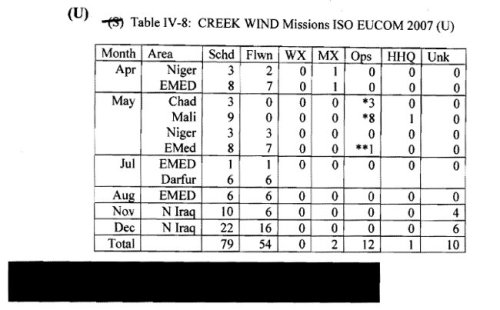One of the things that really got me started on this was collecting information about US intelligence gathering operations in Africa. Its said that in any conflict you can never have too much intelligence and that you probably don’t have as much as you want. This is especially true in Africa where many governments do not have a clear picture of what is going on in much of their country or where their borders even are. Simply mapping things out has been an important task, which the US has assisted in. For instance, the US used a sensor package called BuckEye, designed to collect geospatial intelligence, to map 6,000 square kilometers of Burkina Faso in 2012. The US has also worked to provide high resolution satellite imagery of Africa to its partners for these purposes.

Table IV-8: CREEK WIND Missions ISO EUCOM 2007 (U) from the 2007 Air Combat Command History. The definitions of the asterisks have been redacted.
With many ongoing efforts on the continent, more traditional intelligence support to active operations is also important. Codebook: Africa now provides summaries for nine recent named intelligence gathering missions in support of efforts in Africa. You can find these here. Available information varies, but a lot has been gleaned through freedom of information act requests and scrutinizing various government resources, such as the table above from the 2007 Air Combat Command history.
